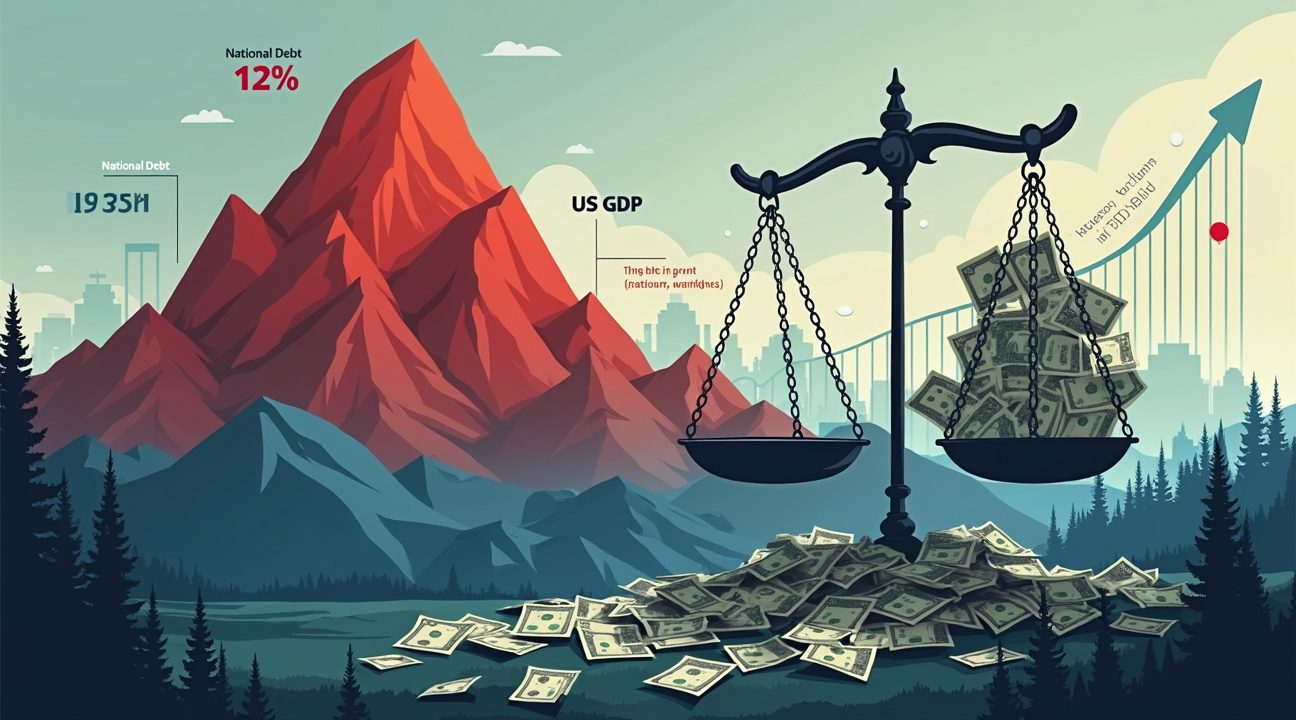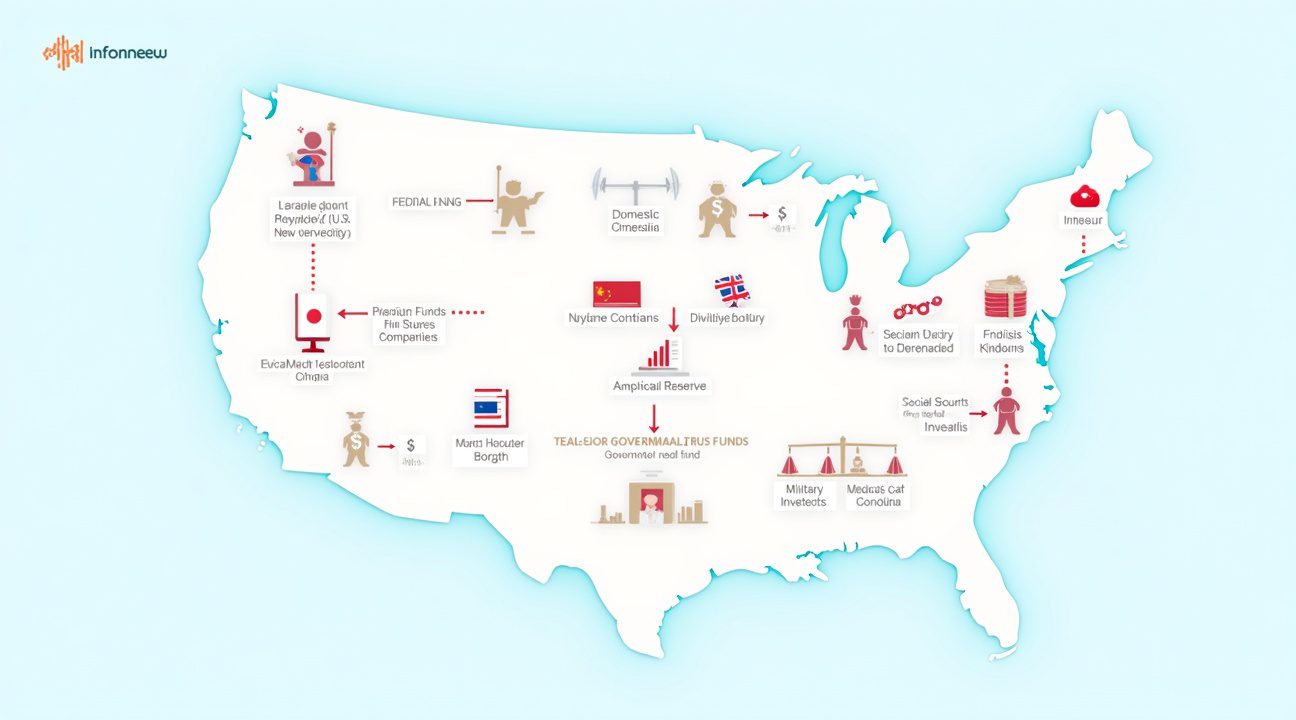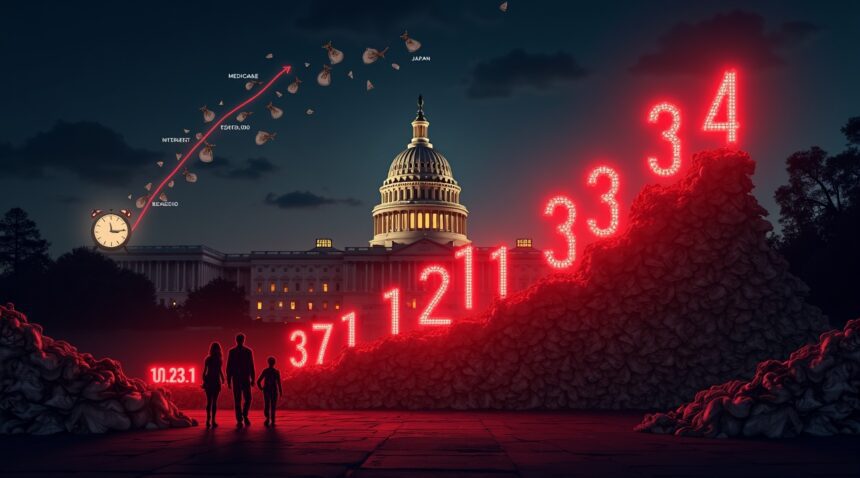The United States national debt has reached an unprecedented $37 trillion as of August 2025—an alarming milestone that reflects the rapid financial trajectory of the nation. In just one year, the country added $1.87 trillion in debt, accumulating at a rate of $59,335 per second, significantly ahead of the Congressional Budget Office’s (CBO) original forecast for 2030.
Key Takeaways
- The national debt reached $37 trillion in August 2025, representing a debt-to-GDP ratio of approximately 119–121%, indicating that government borrowing now exceeds the United States’ entire annual economic output.
- Every American household carries a theoretical debt burden of $279,319, with individual debt responsibility averaging $108,551 per person as of 2025.
- Interest payments now consume $726 billion annually, accounting for 14% of total federal spending—greater than expenditures on both defense and Medicare—with none of these payments offering direct public benefit.
- Foreign holders possess about $7.7 trillion of U.S. debt, while over $29 trillion is held domestically, including through U.S.-based institutions, trust funds, and the Federal Reserve.
- The debt milestone came five years ahead of projections made by the Congressional Budget Office, with current models forecasting the national debt could soar past $52 trillion by 2035.
Additional Resources
For more detailed insights into the U.S. national debt and its economic implications, you can visit the U.S. Debt Clock for real-time updates and data visualizations.
America’s Debt Clock Ticks at $59,335 Every Second as $37 Trillion Milestone Shattered
I witnessed history in the making as the U.S. Treasury Department’s debt counter clicked past an unprecedented threshold. On August 8, 2025, America’s gross national debt reached an astronomical $37,004,817,625,842.56, marking the first time the nation’s borrowing surpassed the $37 trillion mark.
The speed of this financial escalation is staggering. I’ve tracked the numbers closely, and the debt accumulated $1.87 trillion in just one year. Looking at a broader timeframe, the increase over five years totals $10.42 trillion — a figure that represents more than the entire GDP of most developed nations. This translates to an average daily increase of $5.13 billion, meaning the government adds debt faster than most people can comprehend.
Breaking Down the Astronomical Numbers
The rate at which America accumulates debt defies easy understanding.
- Hourly increase: $213.6 million
- Per minute: $3.56 million
- Per second: $59,335
These figures highlight how saving money has become more critical than ever for individual Americans.
Record-Breaking Acceleration Pattern
I’ve observed an alarming acceleration in debt milestone achievements. The trajectory shows the $36 trillion barrier fell in November 2024, while $35 trillion was crossed just one year earlier in July 2024. This pattern reveals debt accumulation occurring at the fastest pace on record, with trillion-dollar milestones now falling within months rather than years.
The Treasury Department’s data confirms this rapid debt accumulation represents a fundamental shift in federal spending patterns. I note that previous trillion-dollar increases typically took several years to materialize, but recent economic policies and spending programs have compressed these timeframes dramatically. Financial experts suggest this acceleration stems from increased government spending on infrastructure, social programs, and interest payments on existing debt.
Current projections indicate the $38 trillion threshold could arrive even sooner than the $37 trillion milestone did. I expect continued monitoring of these figures will reveal whether this acceleration continues or if policy changes might slow the rate of increase. The implications for future generations and global equity markets remain significant considerations as this debt mountain continues growing at breakneck speed.

Your Family’s Hidden $279,319 Debt Burden
I’ve calculated some staggering numbers that reveal just how deeply this debt crisis affects every American family. Each household now shoulders the equivalent of $279,319 in national debt – a figure that represents your family’s share of the government’s spending obligations.
Breaking this down further, the debt burden reaches $108,551 per person, marking a sharp increase from approximately $106,000 per person in 2024. This rapid escalation shows how quickly individual Americans are accumulating their share of government financial obligations, even without any direct borrowing on their part.
Understanding Your Personal Debt Share
The per capita debt calculation divides the total national debt among all U.S. citizens, creating a theoretical burden that follows every American from birth. I find this perspective particularly striking because it transforms abstract government borrowing into concrete personal terms. A family of four now carries over one million dollars in combined debt responsibility, though they never signed a loan document or received any direct benefit from this borrowing.
This household debt burden continues climbing as government spending outpaces revenue collection. Financial planning strategies become increasingly important as families navigate their actual expenses while this theoretical burden grows in the background.
The Acceleration Pattern
The increase from $106,000 to $108,551 per person in just one year demonstrates how rapidly this burden compounds. I observe this acceleration occurring during periods of significant government spending, whether for infrastructure, social programs, or economic stimulus measures. The debt per person metric provides a clear benchmark for tracking how quickly Americans accumulate their share of national obligations.
Interest payments on existing debt contribute significantly to this acceleration, creating a compound effect where Americans bear responsibility for both new borrowing and the growing cost of servicing previous debt. This dynamic means the per capita burden increases even during periods when new government spending remains relatively stable.
Financial experts increasingly reference these per-person calculations when discussing economic trends and their long-term implications for American families. Understanding your theoretical debt share helps contextualize broader economic discussions about fiscal responsibility and government spending priorities.
The $279,319 household figure serves as a wake-up call for families considering their long-term financial security. While families don’t directly pay this debt, its existence influences tax policy, interest rates, and government service funding decisions that ultimately affect household budgets and investment opportunities.
When Your Debt Exceeds Your Entire Economy
The numbers paint a stark picture of America’s fiscal reality. By June 2025, the national debt reached between 119% and 121% of U.S. GDP, marking a significant milestone where borrowing officially surpassed the country’s total annual economic output. This threshold represents more than just an accounting figure—it signals a fundamental shift in how the nation finances its operations.
Breaking Down the Numbers
At the end of the second quarter of 2025, several key metrics emerged that highlight the scope of this financial challenge:
- U.S. GDP stood at $30.3 trillion, representing the total value of goods and services produced
- National debt reached $36.2 trillion, creating a gap of nearly $6 trillion
- The debt-to-GDP ratio climbed to unprecedented levels not seen since World War II
- Public debt holdings, excluding intragovernmental transfers, are projected to hit 99% of GDP by year’s end
I find it crucial to distinguish between total debt and debt held by the public when analyzing these figures. Economists typically focus on public debt because it represents actual borrowing from external sources rather than internal government accounting transfers. This distinction matters significantly when assessing the true burden on taxpayers and global equity markets.
The historical context adds another layer of concern to these developments. The debt-to-GDP ratio stood at 106% in 2016, meaning the fiscal balance has deteriorated substantially over the past decade. This trajectory indicates that government spending has consistently outpaced economic growth, creating an unsustainable pattern that demands attention from policymakers and citizens alike.
What makes this situation particularly challenging is the speed of accumulation. Unlike previous debt spikes during wartime or major economic crises, this increase occurred during relatively stable economic conditions. The implications extend beyond simple arithmetic—when debt exceeds economic output, it affects everything from interest payments to future spending flexibility.
Smart financial planning becomes even more critical for individuals when government debt reaches these levels. People who understand hidden ways to save money position themselves better against potential economic volatility that often accompanies high national debt levels.
The 121% threshold represents a psychological and economic barrier that few developed nations have crossed during peacetime. Each percentage point above 100% means the government owes more than the entire country produces in a year, fundamentally altering the relationship between fiscal policy and economic growth potential.

Interest Payments Now Exceed Defense and Medicare Spending
The financial burden of servicing America’s massive debt has reached a troubling milestone that demands immediate attention. Interest payments on the national debt consumed 10.7% of all federal spending in fiscal year 2023, marking a dramatic shift in how taxpayer dollars are allocated across government functions.
I’ve observed how these debt-servicing costs have climbed to staggering heights, with annualized expenses reaching $726 billion as of July 2023. This represents 14% of total federal spending, meaning one out of every seven dollars the government spends now goes directly to creditors rather than funding essential services or infrastructure investments.
The magnitude becomes even more striking when comparing these interest payments to traditional government priorities. These obligations have actually surpassed what the nation spends on both Medicare and defense programs in recent years. While defense spending typically commands significant public attention and Medicare serves millions of Americans, the silent drain of interest payments now exceeds both categories without delivering any direct benefits to citizens.
Rising Deficit Trajectory Accelerates the Problem
Current fiscal trends suggest this situation will worsen rapidly. The federal deficit for fiscal year 2025 reached $1.3 trillion as of June, maintaining a concerning pace similar to the previous year. Even though revenues increased by 3%, spending jumped by 7%, creating an unsustainable gap that requires additional borrowing.
Several factors contribute to this accelerating debt spiral:
- Recent legislation continues adding substantial amounts to future obligations
- Rising interest rates increase the cost of servicing existing debt
- Automatic spending increases in entitlement programs outpace revenue growth
- Economic uncertainties make it difficult to implement meaningful fiscal reforms
Recent policy decisions, including President Trump’s 2025 tax and spending package, are projected to add $4.1 trillion to the national debt over the next decade. These additions occur precisely when the government faces mounting pressure from existing interest obligations, creating a compounding effect that threatens long-term fiscal stability.
The crowding-out effect presents perhaps the most serious concern for future governance. As interest obligations consume an ever-larger portion of federal resources, they reduce the government’s ability to respond to emergencies, invest in critical infrastructure, or address emerging challenges. This fiscal inflexibility could prove devastating during economic downturns or national security crises when rapid government action becomes essential.
I recognize that this debt trajectory creates difficult choices for policymakers. Every dollar spent on interest payments represents a dollar unavailable for education, healthcare improvements, or economic development programs. The opportunity cost extends beyond immediate spending decisions, as reduced fiscal flexibility limits the government’s capacity to implement countercyclical policies during recessions.
The comparison to global equity markets reveals how investors increasingly view U.S. debt sustainability as a risk factor. While Treasury securities remain highly sought after, continued growth in debt-to-GDP ratios could eventually undermine this privileged position.
Addressing this challenge requires acknowledging that current spending patterns are unsustainable. The arithmetic is straightforward: when interest payments grow faster than the underlying economy, debt becomes an increasingly heavy burden that constrains future generations. Unlike defense or Medicare spending, which provide tangible benefits, interest payments represent pure financial overhead that diverts resources from productive uses.
The trajectory suggests that without significant policy changes, interest payments could consume 20% or more of federal spending within the next decade. This scenario would fundamentally alter how the federal government operates, forcing dramatic reductions in discretionary spending or requiring substantial tax increases to maintain current service levels.
Financial experts increasingly recognize that addressing this issue requires both revenue enhancements and spending reforms. However, the political challenges of implementing such measures grow more difficult as interest obligations consume larger portions of the budget, leaving fewer resources available for popular programs that build public support for fiscal responsibility.
Who Actually Owns America’s $37 Trillion Debt
I often hear concerns about who holds America’s massive debt load, and the composition is more diverse than most people realize. Understanding this breakdown reveals important insights about financial stability and economic relationships.
Foreign Holdings and International Creditors
Foreign entities control approximately $7.7 trillion of the national debt as of December 2021. This represents a significant portion, but it’s far from the majority that many Americans assume. China and Japan traditionally rank as the largest foreign holders, though their positions fluctuate based on economic conditions and policy decisions. Other major foreign creditors include the United Kingdom, Ireland, and Luxembourg, along with various sovereign wealth funds and international financial institutions.
These foreign holdings create both opportunities and vulnerabilities. While international investment in U.S. Treasury securities demonstrates global confidence in American economic stability, it also means that global equity markets can influence domestic fiscal policy decisions.
Domestic Ownership Structure
Debt held by the public, including marketable Treasury securities, totaled $29 trillion as of March 2025. This category encompasses domestic investors like pension funds, insurance companies, mutual funds, banks, and individual Americans who purchase government bonds. Federal Reserve holdings also fall into this classification, representing a substantial portion through various monetary policy programs.
The remaining debt consists of intragovernmental holdings, which stood at about $7.4 trillion. These represent IOUs between different government agencies and trust funds. The largest concentration sits within the Social Security Trust Fund at $2.7 trillion, followed by federal civilian and military retirement programs, Medicare trust funds, and other internal government accounts.
This internal debt structure means the government essentially owes money to itself in many cases. Social Security operates by investing surplus contributions in Treasury securities, creating a self-reinforcing cycle where one government program lends to another. When Social Security needs to pay benefits exceeding current contributions, it redeems these securities, requiring the Treasury to find alternative funding sources.
Military and civilian retirement programs follow similar patterns, holding Treasury securities as investments for future benefit payments. Medicare trust funds operate under comparable structures, though their financial pressures vary based on healthcare cost trends and demographic changes.
The debt composition reveals why hidden ways to save money matter for both individual households and government finances. Private investors, including Americans saving for retirement through various investment vehicles, indirectly support government operations while seeking stable returns.
Banks and financial institutions purchase Treasury securities as safe investments required by regulatory capital requirements. Insurance companies rely on government bonds to match long-term liabilities with stable assets. This creates a symbiotic relationship where government funding needs align with private sector investment requirements.
State and local governments also hold portions of federal debt through their pension funds and investment portfolios. This interconnected web means that federal fiscal health directly impacts retirement security for millions of Americans across multiple sectors.
Understanding this ownership structure helps explain why debt sustainability depends on maintaining investor confidence across diverse stakeholder groups. Foreign creditors provide crucial funding but can shift investments based on relative returns and geopolitical considerations. Domestic institutional investors offer more stability but face their own constraints based on regulatory requirements and fiduciary responsibilities.
The intragovernmental component creates unique dynamics since these obligations represent commitments to future beneficiaries rather than external creditors. This distinction matters for policy discussions about debt reduction and fiscal reform, as internal restructuring differs significantly from managing external obligations.

The Debt Crisis Arrived 5 Years Early
I never expected the debt milestone to arrive this quickly. The Congressional Budget Office had projected America’s national debt would reach $37 trillion by 2030, but accelerated government borrowing completely upended that timeline. Pandemic relief measures and additional fiscal legislation pushed this concerning benchmark forward by approximately five years, demonstrating just how rapidly fiscal conditions can deteriorate.
The federal government responded to this escalating debt situation by raising the statutory debt ceiling from $31.38 trillion to $41.1 trillion. This adjustment permits continued government borrowing while the nation grapples with its mounting financial obligations. However, this temporary fix doesn’t address the underlying spending patterns that created the crisis in the first place.
Projections Paint an Alarming Picture
The Congressional Budget Office now projects even more sobering figures for the future. Current estimates suggest the national debt could exceed $52 trillion by 2035, representing an unprecedented level of government indebtedness. The United States already holds the highest level of external debt globally, and this trajectory only amplifies existing concerns about fiscal sustainability.
Several factors continue driving this debt expansion beyond immediate control:
- An aging population places increasing pressure on Social Security and Medicare systems.
- Escalating healthcare costs compound these obligations significantly.
- Demographic shifts and legislative spending remain persistent forces pushing expenditures higher.
Recent legislative actions have influenced both current and future debt trends. The Fiscal Responsibility Act of 2023 attempted to address some spending concerns, yet large-scale spending bills continue contributing to the overall debt accumulation. Key trends developing in global equity markets often reflect investor concerns about sovereign debt levels and their potential impact on economic stability.
The sustainability of current U.S. fiscal policy faces serious questions as debt service costs consume an ever-larger portion of the federal budget. Interest payments on existing debt reduce available funds for other government priorities, creating a concerning cycle where borrowing becomes necessary just to maintain basic operations.
Partisan disagreement continues hampering efforts to address these mounting fiscal challenges. Different political factions propose varying approaches to debt management, from spending cuts to revenue increases, yet consensus remains elusive. This political gridlock occurs while debt continues accumulating at an accelerating pace.
I find it particularly concerning that this debt milestone arrived five years ahead of schedule, suggesting that previous projections may have underestimated the speed of fiscal deterioration. Hidden ways to save money that individuals employ pale in comparison to the scale of adjustments needed at the federal level to address this crisis effectively.

Sources:
Fox Business, “US national debt hits record $37 trillion”
USAFacts, “How much debt does the US have?”
NEWS CENTER Maine, “US national debt reaches record $37 trillion”
Bipartisan Policy Center, “Deficit Tracker”
Joint Economic Committee, “Monthly Debt Update (August 2025)”
Wikipedia, “National debt of the United States”
Pew Research Center, “Key facts about the U.S. national debt”
Committee for a Responsible Federal Budget, “Q&A: Gross Debt Versus Debt Held by the Public”


